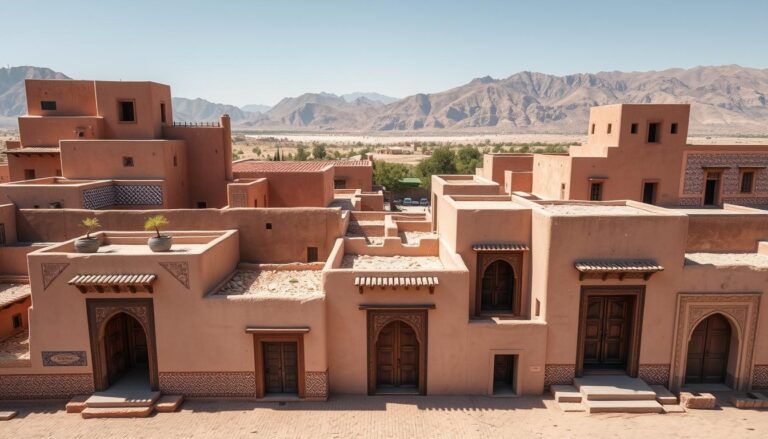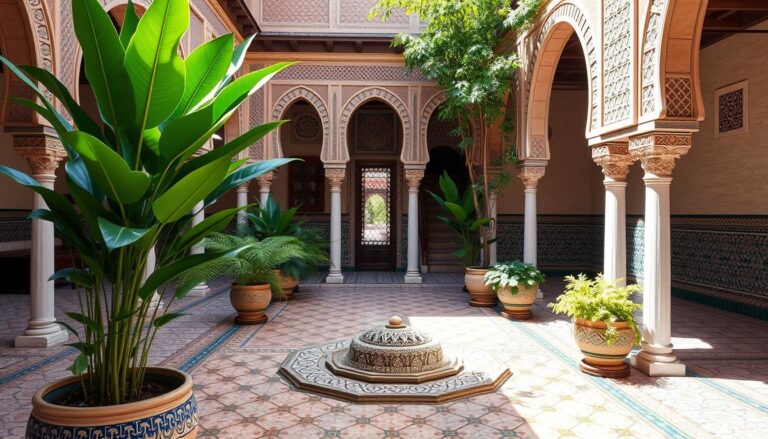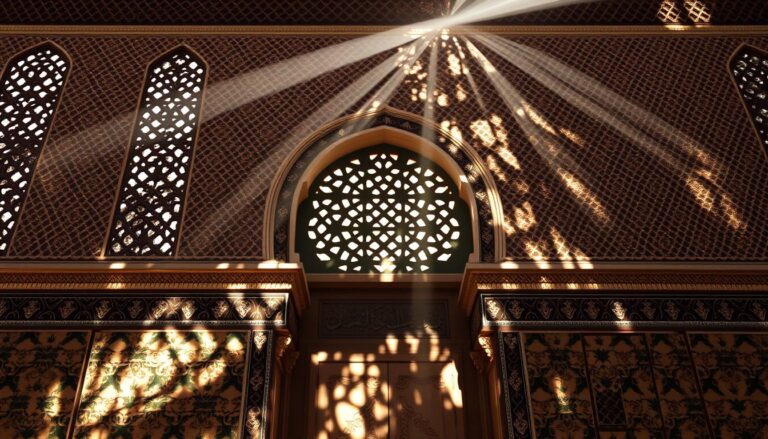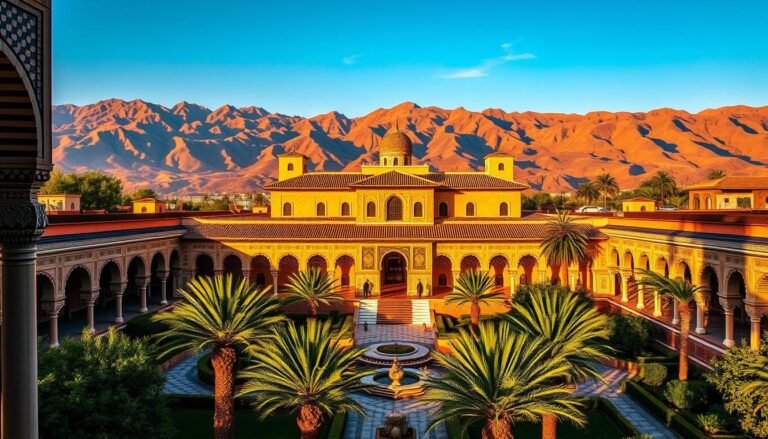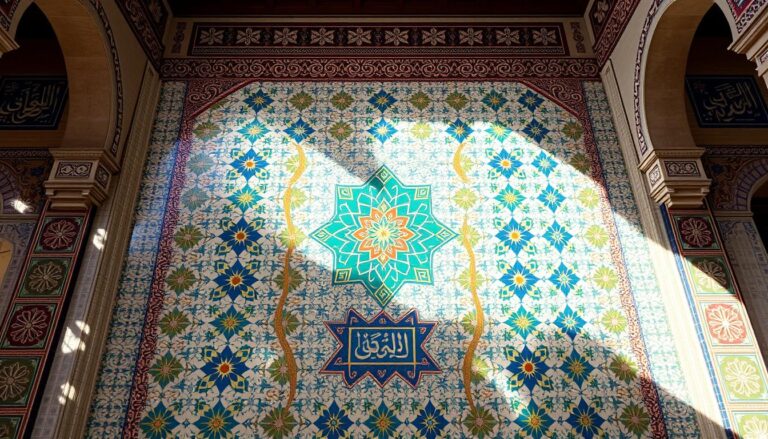Morocco’s architecture has captivated people worldwide. The Hassan II Mosque in Casablanca and the Bahia Palace in Marrakesh are just a few examples. They show a mix of Amazigh, Islamic, and colonial styles.
Key Takeaways
- Moroccan architecture blends Amazigh, Islamic, and colonial influences to create a distinct style
- Iconic buildings like the Hassan II Mosque and Bahia Palace exemplify the country’s architectural legacy
- Moorish and Andalusian design elements, such as horseshoe arches and intricate tilework, are hallmarks of Moroccan architecture
- Modernist and neo-Moorish styles emerged in the 20th century, further diversifying Morocco’s architectural landscape
- Ancient Roman and early Islamic sites showcase the deep roots of Moroccan architecture
The Hassan II Mosque: Casablanca’s Grand Monument
The Hassan II Mosque stands tall in Casablanca, a city by the sea. It’s a huge mosque, one of the biggest in the world. Built in 1993 after seven years, it shows off Morocco’s rich Moorish and Islamic designs.
Design and Construction
The Hassan II Mosque is huge, the second-largest in Africa and the 14th globally. Its 210-meter minaret is the second-tallest. It can hold up to 105,000 people, with 25,000 inside and 80,000 outside.
It took over 10,000 artists and craftsmen to build. The cost was around $400 to $700 million.
Architectural Features and Influences
The Hassan II Mosque is a masterpiece of Moorish and Islamic design. Its tile work, arches, and minaret show Moorish style. The mosque’s size and beauty reflect Islamic traditions.
Materials like marble, granite, and cedar wood add to its beauty. These materials make the mosque stand out.
“The Hassan II Mosque in Casablanca is a true architectural marvel, combining the finest elements of Moorish and Islamic design to create a building that is both visually stunning and deeply meaningful.”
Alhambra Palace: Islamic Architecture in Andalusia
The Alhambra Palace in Andalusia, Spain is a stunning example of Islamic architecture. It has greatly influenced Moroccan design. Built during the Nasrid dynasty in the 13th and 14th centuries, it shows the intricate style of Moorish architecture.
The palace is known for its elaborate tilework, delicate arches, and serene courtyards. These features reflect the refined aesthetic found in many Moroccan buildings. The complex includes at least six major palaces, with the Mexuar, Comares Palace, Palace of the Lions, and Partal Palace being the most famous.
The Alhambra’s architecture is a blend of Moorish architecture. It focuses on courtyards with central water features, tile mosaics, and carved stucco. The name “Alhambra” comes from the Arabic word for ‘the red one’, due to its red walls made from local clay.
“The Alhambra is a masterpiece of medieval architecture, reflecting the glory of the last days of Moorish civilization in Spain.”
The Alhambra was named a UNESCO World Heritage Site in 1984. It is now a major tourist attraction in Spain. During the Nasrid era, it was a self-contained city with amenities like a mosque, public baths, and workshops.
The Bahia Palace: Marrakesh’s Jewel of Islamic Art
In the heart of Marrakesh, the Bahia Palace is a marvel of Moroccan Islamic architecture. It took 14 years to build in the late 1800s. This palace shows off the Alaouite architectural style’s finest craftsmanship and opulence.
History and Construction
Si Moussa, a powerful grand vizier in the 19th century, built the Bahia Palace. He brought in top artisans from all over Morocco. Their work created a palace with marble courtyards, gardens, and detailed decorations that are loved by all.
Intricate Decorations and Design Elements
Visitors to the Bahia Palace are amazed by the colorful tilework, Islamic-style arches, and carved wooden details. The painted ceilings and ornate plasterwork inside are stunning. The harem has stained glass and dainty silk panels, adding to its luxury. The courtyards and gardens show the beauty of Moroccan design, blending indoor and outdoor spaces.
“The Bahia Palace is a true masterpiece of Islamic architecture and a testament to the skilled craftsmanship of Moroccan artisans.”
The Bahia Palace in Marrakesh is a prime example of the city’s rich Moorish architecture and culture. It draws visitors from all over the world with its detailed decorations and design.
Famous global buildings with Moroccan influence
Moroccan architecture has made a lasting impact worldwide. It combines Berber, Islamic, and Moorish styles. The Koutoubia Mosque in Marrakesh stands tall, and the Mausoleum of Mohammed V in Rabat is a marvel of white marble and tilework.
In Meknes, the Mausoleum of Moulay Ismail is a sight to behold. Chefchaouen is famous for its blue buildings and the Grand Mosque’s unique octagonal minaret. These buildings show how Moroccan architecture has influenced designs globally.
The Alhambra Palace in Spain is a prime example of Moroccan-inspired architecture. It’s a UNESCO World Heritage site. The Sheikh Zayed Grand Mosque in the United Arab Emirates and the Blue Mosque in Istanbul, Turkey, also reflect Moroccan Islamic architecture.
These buildings prove the lasting appeal of Moroccan design. Architects worldwide have been inspired by its vibrant colors, intricate patterns, and iconic forms. Moroccan architecture’s influence is clear and powerful.
Moroccan Riads: Courtyard Homes of Tradition
Moroccan riads are architectural wonders that have lasted for centuries. These homes face inward, around a central courtyard. This design shows the value of privacy and family in Moroccan culture.
Inside, you’ll find beautiful tilework, carved wood, and ornate plaster. There are also lush gardens and fountains. This mix of indoor and outdoor spaces is a key feature of Moroccan architecture.
Layout and Design Principles
The classic riad garden is a rectangular shape with four quadrants. Two paths meet in the center. This design is not just pretty; it also helps keep the home cool in the hot Moroccan climate.
- Riads in Marrakesh have high walls for privacy and security. Windows look out to the courtyard, not the outside.
- The courtyard garden keeps the home cooler, up to 15 degrees Celsius (60 degrees Fahrenheit) lower than outside.
- Even when it’s 45°C (113°F) in June, riads stay cool without air conditioning. Their design helps air circulate and cool the space.
Riad architecture comes from Mediterranean and Middle Eastern styles, influenced by Moorish culture. The word “riad” means gardens in Arabic. This shows how important green spaces are in these homes.
“Moroccan buildings can cut cooling energy use by up to 50% compared to homes using air conditioning solely.”
Today, Moroccan design blends old and new, using eco-friendly options with traditional materials like clay and wood. This shows the lasting beauty and practicality of these architectural wonders.
Andalusian Architecture: Blending Moorish and Spanish Styles
The architecture of Andalusia, Spain’s southern region, is a mix of Moorish and Spanish styles. This blend is seen in many famous buildings that have lasted for centuries. They show the lasting impact of Andalusian architecture.
Iconic Buildings and Landmarks
The Alhambra Palace in Granada is a prime example. It has Moorish tilework and arches, mixed with Spanish Renaissance grandeur. The Giralda Tower in Seville also shows this mix. Originally a minaret, it now holds bells, blending Moorish and Spanish designs.
The Hassan Tower in Rabat, Morocco, looks a lot like the Giralda Tower. This similarity shows the architectural exchange between the Iberian Peninsula and North Africa during the Moorish era.
“These landmark buildings demonstrate the enduring legacy of Andalusian architecture, which continues to inspire Moroccan design to this day.”
The mix of Moorish and Spanish styles in Andalusian architecture is unique and beautiful. It attracts visitors from all over. The Alhambra’s tilework and the towers in the sky are proof of the region’s rich cultural history.
Conclusion
Moroccan architecture is a mix of ancient traditions and grand styles. It shows the influence of Roman, Berber, Moorish, and Islamic art. This blend is seen in famous buildings like the Hassan II Mosque and the Alhambra Palace.
This unique style has made Moroccan architecture famous worldwide. It combines local designs with the beauty of Moorish and Islamic art. This creates a style that amazes and inspires people everywhere.
The buildings in Morocco are full of beauty, with zellige tiles, carved wood, and brass engravings. These details show the skill and care of Moroccan craftsmen over the years. This cultural legacy shows Morocco’s rich history and its lasting impact on architecture globally.
Travelers and architecture fans visiting Morocco will be amazed by its buildings. They see how Moorish, Islamic, and local designs come together. This makes Morocco’s architecture truly special and inspiring.
The work to keep these historic buildings, like the Moorish houses in Albayzin, is crucial. It shows how important Moroccan architecture is to the world. It continues to inspire and fascinate people everywhere.
Source Links
- Moroccan architecture
- Majestic Moroccan Architecture In 10 Buildings
- Hassan II Mosque
- Hassan II Mosque Casablanca – Morocco – All You Need To Know, 2024
- The Hassan 2 Mosque Mosquée Hassan 2
- The Top 20 Examples – Architecture of Cities
- Alhambra
- The 10 Best Museums to visit in Marrakech | Blondie in Morocco
- Marrakech Marvels: Unearthing the Historical Treasures 🕌🏰
- From Islamic to Art Deco: A rich history of Moroccan architecture
- The Legacy of Brutalism on Morocco’s Post-independence Architectural Landscape
- 12 of the Best Examples of Islamic Architecture in the World
- Riad (architecture)
- The Timeless Design of Moroccan Homes
- Moroccan Riad Architecture
- Moorish architecture
- Moorish Architecture in Andalusian Cities: A Deep Dive
- The Enduring Echoes of Moorish Spain (Published 2022)
- A journey through Moroccan architecture, Casablanca & Rabat
- A Journey Through Andalusian Influence and Artistic Mastery – Art Maze
- Moorish Houses of Granada

The Editorial Team is a passionate group of Morocco enthusiasts dedicated to sharing the beauty, culture, and wonders of this captivating country. With diverse backgrounds and a deep love for travel, we strive to bring you engaging and informative content that inspires your Moroccan adventures. From uncovering hidden gems and sharing local insights to exploring mouthwatering cuisine and showcasing the vibrant lifestyle, our team is committed to providing you with valuable resources and exciting stories that enhance your exploration of Morocco. Join us on this journey as we celebrate the rich heritage and unforgettable experiences that make Morocco truly special.


